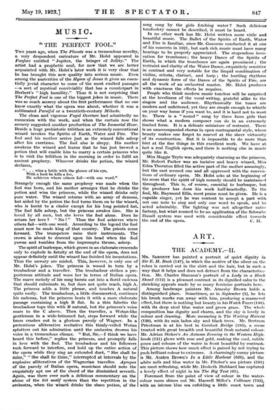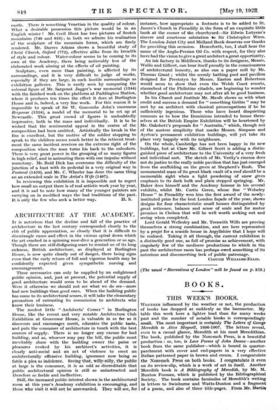ART.
THE ACADEMY.—II.
Ma. SARGENT has painted a portrait of quiet dignity in Sir E. H. Busk (147), in which the motive of the silver on the robes is carried out in the shirt and the hair, but in such a way that it helps and does not detract from the characteriza- tion. Mr. Charles Shannon's portrait of a Lady in a Black Shawl (112) is a pleasant contrast in its dignified calm to the shrieking appeals made by so many feminine portraits here.
Among landscape painters Mr. Arnesby Brown holds a distinguished place. Sometimes, as in September (8), he lets his brush marks run away with him, producing a mannered effect, but there is nothing but beauty in his Watch Tower (148), with its deep steel blue water and green grass. The whole composition has dignity and charm, and the sky is lovely in colour and drawing. More menacing is The Waiting Harvest (130), with its rain laden sky and black trees. Mr. Bertram Priestman is at his best in Gairloch Bridge (195), a scene treated with great breadth and beautiful fresh natural colour. Mr. Adrian Stokes's An Autumn Evening in the Western High- lands (151) glows with rose and gold, making the cool, subtle tones and colours of the water in front beautiful by contrast. This picture shows how much effect is gained by not trying to push brilliant colour to extremes. A charmingly sunny picture is Mr. Austen Brown's In a LiU/o Harbour (656), and the white sails and blue water in Mr. Pitcher's sea picture (581) are most refreshing, while Mr. Hesketh Hubbard has captured a lovely effect of night in his The Big Tent (61).
Foremost from the point of view of colour in the water- colour room shines out Mr. Haswell Miller's Collioure (785), with an intense blue sea enfolding a little coast town and castle. ,There is something Venetian in the quality of colour. What a desirable possession this picture would be in an English winter 1 Mr. Cecil Hunt has two pictures of Scotch mountains (740 and 816) ; in both we admire his realization of the sculpture of the mountain forms, which are finely rendered. Mr. Dacres Adams shows a beautiful study of Christ Church, Oxford (772), effective alike from its breadth of style and colour. Water-colour seems to be coming to its own at the Academy, there being noticeably less of the elaborated work aiming at the effects of oil painting.
Sculpture, even more than painting, is affected by its surroundings, and it is very difficult to judge of works, especially if they are large, in such hostile surroundings as exhibition galleries. This is easily seen by comparing the colossal figure of Mr. Sargeant Jagger's war memorial (1344) with the finished work on the platform at Paddington Station, where it produces ten times the effect it does at Burlington House and is, indeed, a very fine work. For this reason it is impossible to speak of Sir W. Goscombe John's enormous Response (1524), a model of the memorial to be set up at Newcastle. This great crowd of figures is undoubtedly impressive, both in the mass and individually. It is to be wished that the sentimental appeal in the centre of the composition had been omitted. Artistically the break in the line is excellent, but the motive of the soldier stopping to speak to the children seems much better in the reticent treat- ment the same incident receives on the extreme right of the composition when the man turns his back to the onlookers. There is very great power in the grouping of so many figures in high relief, and in animating them with one impulse without monotony. Mr. Reid Dick has overcome the difficulty of the junction of a bust with its pedestal in a very original way in Pastoral (1459), and Mr. C. Wheeler has done the same thing on an extended scale in The Artist's Wife (1497).
In reviewing this exhibition it is impossible not to regret how small an output there is of real artistic work year by year, and it is sad to note how many of the younger painters are carrying on in modified ways the bad traditions of the past.
It is only the few who seek a better way. IL S.











































 Previous page
Previous page